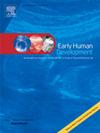Cord blood-derived cell therapies for preterm brain injury
IF 2
3区 医学
Q2 OBSTETRICS & GYNECOLOGY
引用次数: 0
Abstract
Preterm birth, defined as delivery before 37 weeks of gestation, remains a leading contributor to neonatal morbidity and long-term neurodevelopmental impairments. Brain injuries such as intraventricular haemorrhage, white matter injury and hypoxic-ischemic encephalopathy are common in this population and are mediated by overlapping pathophysiological mechanisms including inflammation, cerebrovascular immaturity, cell death and impaired repair. Current therapeutic options for these conditions are limited and are largely supportive. Umbilical cord blood (UCB)-derived cell therapy has emerged as a novel strategy to target these shared pathophysiological pathways. UCB contains diverse cell types—hematopoietic stem cells, mesenchymal stromal cells, endothelial progenitor cells and regulatory T cells—with regenerative, immunomodulatory and neuroprotective properties. Preclinical studies in rodent and limited large-animal models show consistent benefits of UCB therapy, including attenuation of neuroinflammation, reduced apoptosis, promotion of oligodendrocyte maturation and improved functional outcomes. However, variability in model design and lack of long-term endpoints hinder clinical translation. Clinical research into cord blood-derived therapies for preterm brain injury is still in its early stages, with most studies to date focused on feasibility and safety rather than efficacy. While preventative approaches have dominated, therapeutic trials for infants with established brain injury remain limited. Small case series suggest potential benefits in intraventricular haemorrhage, but other injury types, such as hypoxic-ischemic encephalopathy, stroke, or cerebellar haemorrhage, remain largely unexplored in the preterm population. Recent studies using reinfusion of a preterm infant's own cord blood derived cells show promising safety and early signs of reduced risk for conditions like cerebral palsy. Larger efficacy trials are now underway, including those targeting severe, established preterm brain injuries, marking a significant step toward clinical application.
脐带血来源细胞治疗早产儿脑损伤
早产,定义为妊娠37周前分娩,仍然是新生儿发病率和长期神经发育障碍的主要原因。脑损伤如脑室内出血、白质损伤和缺氧缺血性脑病在这一人群中很常见,并由重叠的病理生理机制介导,包括炎症、脑血管不成熟、细胞死亡和修复受损。目前对这些疾病的治疗选择是有限的,并且在很大程度上是支持性的。脐带血(UCB)来源的细胞治疗已经成为一种针对这些共同病理生理途径的新策略。UCB包含多种细胞类型-造血干细胞,间充质基质细胞,内皮祖细胞和调节性T细胞-具有再生,免疫调节和神经保护特性。在啮齿动物和有限的大型动物模型中进行的临床前研究显示,UCB治疗具有一致的益处,包括减轻神经炎症、减少细胞凋亡、促进少突胶质细胞成熟和改善功能结果。然而,模型设计的可变性和缺乏长期终点阻碍了临床转化。脐带血来源治疗早产儿脑损伤的临床研究仍处于早期阶段,迄今为止大多数研究都侧重于可行性和安全性,而不是有效性。虽然预防方法占主导地位,但对已确定脑损伤的婴儿的治疗试验仍然有限。小病例系列提示脑室内出血的潜在益处,但其他类型的损伤,如缺氧缺血性脑病、中风或小脑出血,在早产儿人群中仍未得到充分研究。最近的研究使用早产儿自己的脐带血来源的细胞进行再输注,显示出良好的安全性和早期迹象,降低了患脑瘫等疾病的风险。目前正在进行更大规模的疗效试验,包括针对严重的、已确定的早产儿脑损伤的试验,这标志着向临床应用迈出了重要的一步。
本文章由计算机程序翻译,如有差异,请以英文原文为准。
求助全文
约1分钟内获得全文
求助全文
来源期刊

Early human development
医学-妇产科学
CiteScore
4.40
自引率
4.00%
发文量
100
审稿时长
46 days
期刊介绍:
Established as an authoritative, highly cited voice on early human development, Early Human Development provides a unique opportunity for researchers and clinicians to bridge the communication gap between disciplines. Creating a forum for the productive exchange of ideas concerning early human growth and development, the journal publishes original research and clinical papers with particular emphasis on the continuum between fetal life and the perinatal period; aspects of postnatal growth influenced by early events; and the safeguarding of the quality of human survival.
The first comprehensive and interdisciplinary journal in this area of growing importance, Early Human Development offers pertinent contributions to the following subject areas:
Fetology; perinatology; pediatrics; growth and development; obstetrics; reproduction and fertility; epidemiology; behavioural sciences; nutrition and metabolism; teratology; neurology; brain biology; developmental psychology and screening.
 求助内容:
求助内容: 应助结果提醒方式:
应助结果提醒方式:


